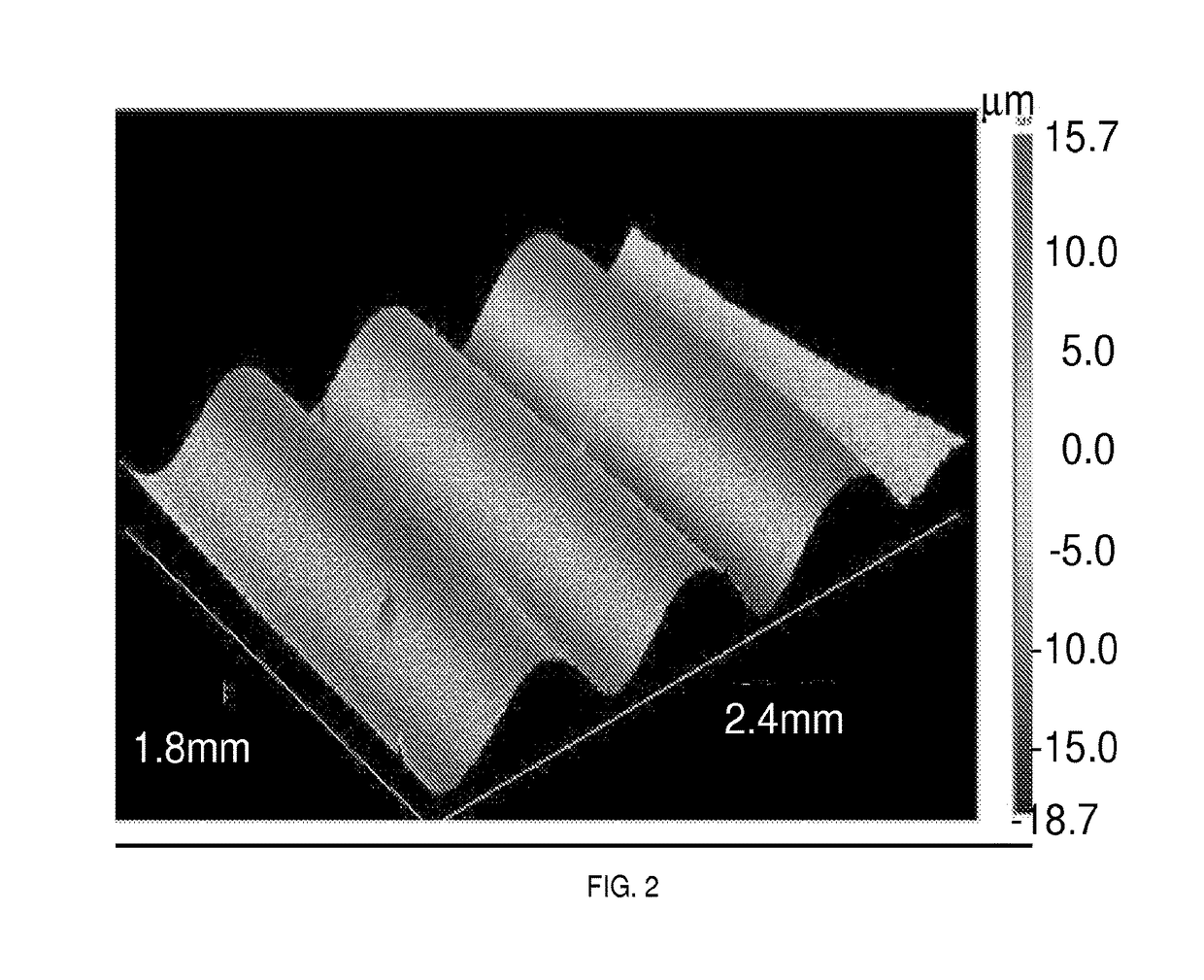Modified elastomer surface
a technology of elastomer and surface, which is applied in the direction of separation processes, membranes, coatings, etc., can solve the problems of reducing the type and size of patterns available, requiring tedious manufacturing steps, etc., and achieves the effects of reducing size, increasing efficiency and less cos
- Summary
- Abstract
- Description
- Claims
- Application Information
AI Technical Summary
Benefits of technology
Problems solved by technology
Method used
Image
Examples
example 1
ith Spheroidal Features
[0094]In a polypropylene mixing cup was combined about 6 g of a composition prepared by mixing about 94 parts dimethylvinylsiloxy-terminated polydimethylsiloxane having a viscosity of about 2 Pa⋅s at 25° C., about 32 parts of organopolysiloxane resin consisting essentially of CH2═CH(CH3)2SiO1 / 2 units, (CH3)3SiO1 / 2 units, and SiO4 / 2 units, wherein the mole ratio of CH2═CH(CH3)2SiO1 / 2 units and (CH3)3SiO1 / 2 units combined to SiO4 / 2 units is about 0.7, and the resin has weight-average molecular weight of about 22,000, a polydispersity of about 5, and contains about 1.8% by weight (about 5.5 mole %) of vinyl groups, about 0.1 parts of Karstedt's catalyst), about 0.2 parts tetramethyltetravinyltetracyclosiloxane, and about 5.5 parts of a polydimethylsiloxane-polyhydridomethylsiloxane copolymer having an average viscosity of about 0.005 Pa⋅s at 25° C. and including 0.8 wt % H in the form of SiH. Between addition of each component, the contents were mixed for a 20 s ...
example 2
ith Continuous Parallel Sinusoidal Features
[0095]The mixture used in Example 1 was prepared and placed in a vacuum chamber to de-gas in a similar manner. A glass mold comprising two glass plates separated by spacers to yield a sample thickness of about 1 mm was filled with the mixture and placed in a 120° C. oven for 25 minutes. The thickness of the elastomer was confirmed with a micrometer. After curing in the oven, the plates and spacers of the mold were removed, and the PDMS elastomer was stretched in one direction manually and secured onto a glass slide. The elastomer was then placed in a nitrogen environment and a solution containing 5.009 g of nBA, 0.105 g of ethylene glycol dimethacrylate (EGDMA), and 0.051 g of TEB-PDA was placed on top of the elastomer for 20 minutes covering the exposed surface. After 20 minutes, excess solution was removed and the elastomer was placed in an acetic acid vapor chamber also in a nitrogen environment for 30 minutes in order to polymerize the ...
example 3
[0096]The winkled surface generated in Example 1 was swollen with heptane, causing the wrinkled pattern, increasing wrinkle amplitude and disorder in the pattern. The heptane was evaporated, causing the original wrinkled pattern to re-appear.
[0097]FIG. 3A illustrates the wrinkle pattern before being swollen with heptane. FIG. 3B illustrates the wrinkle pattern after being swollen with heptane. FIG. 3C illustrates the wrinkle pattern wherein the left side of the elastomer has been swollen with heptane and the right side of the elastomer has not. The heptane-swollen patterned elastomer can be seen to have a higher wrinkle amplitude and a more disordered wrinkle pattern.
PUM
| Property | Measurement | Unit |
|---|---|---|
| wt % | aaaaa | aaaaa |
| wt % | aaaaa | aaaaa |
| wt % | aaaaa | aaaaa |
Abstract
Description
Claims
Application Information
 Login to View More
Login to View More - R&D
- Intellectual Property
- Life Sciences
- Materials
- Tech Scout
- Unparalleled Data Quality
- Higher Quality Content
- 60% Fewer Hallucinations
Browse by: Latest US Patents, China's latest patents, Technical Efficacy Thesaurus, Application Domain, Technology Topic, Popular Technical Reports.
© 2025 PatSnap. All rights reserved.Legal|Privacy policy|Modern Slavery Act Transparency Statement|Sitemap|About US| Contact US: help@patsnap.com



